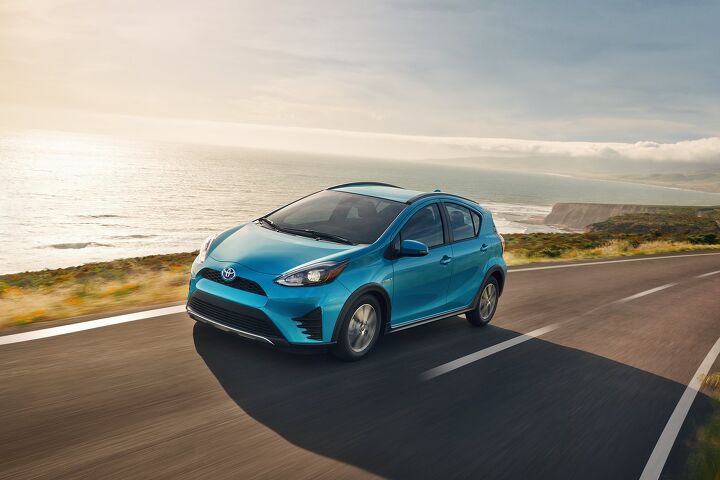Oh No They Didn't: Overnight, Toyota Turns 2018 Prius C Into a Land Cruiser Pretender
It started last year. Toyota, in concert with upgrading the Prius C with Toyota Safety Sense C added a matte black bodykit to the lower portions of the 2017 Prius C.
But for 2018, the Toyota Prius C is a veritable off-roader — a Rubicon-rolling, 4×4 river-fording FJ Cruiser successor.
The 2018 Prius C’s black cladding reaches up and around the wheel arches, and that cladding is interrupted at the Prius C’s chin by skidplate-aping metallic accents, heaven forfend.
Although the Toyota Prius C has migrated from the passenger car world to the trail-running SUV arena with nary a ride height increase and the same front-wheel-drive architecture, Toyota has managed to avoid fuel economy degradation. The 2018 Prius C is rated at 48 miles per gallon city, 43 highway, and 46 mpg combined, same as before.
More seriously, is crossoveresque styling enough to spur a measure of demand for the oft-rejected Prius C? Relatively uncommon upon its debut, U.S. Prius C sales peaked at 41,979 units in 2013, its first full year. But by 2016, sales were less than half that strong, plunging 47 percent from 2015 levels. Compared with last year’s poor performance, sales through the first half of 2017 tumbled a further 39 percent. Only 7,049 Prius Cs were sold in America during the first six months of 2017.
So far this year, the Prius C’s share of America’s subcompact market has fallen to 3.6 percent (from 4.8 percent a year ago) as Toyota generates the bulk of its subcompact sales with the Mazda 2-based Toyota Yaris iA. The Yaris iA and Yaris hatchback combine to outsell the Prius C by nearly four-to-one.
With no meaningful mechanical upgrades, the 2018 Toyota Prius C will still be the car that, according to Car And Driver, accelerates from 0-60 miles per hour in 10.9 seconds. Don’t expect to be thrilled, unless of course you leave the pavement and head up a mountain pass in the middle of a post-mudslide snowstorm.
The 2018 Toyota Prius C has a base price of $21,525, up almost $500 compared with the 2017 Toyota Prius C One.
[Images: Toyota]
Timothy Cain is a contributing analyst at The Truth About Cars and Autofocus.ca and the founder and former editor of GoodCarBadCar.net. Follow on Twitter @timcaincars.
More by Timothy Cain
Latest Car Reviews
Read moreLatest Product Reviews
Read moreRecent Comments
- Spectator Wild to me the US sent like $100B overseas for other peoples wars while we clammer over .1% of that money being used to promote EVs in our country.
- Spectator got a pic of that 27 inch screen? That sounds massive!
- MaintenanceCosts "And with ANY car, always budget for maintenance."The question is whether you have to budget a thousand bucks (or euro) a year, or a quarter of your income.
- FreedMike The NASCAR race was a dandy. That finish…
- EBFlex It’s ironic that the typical low IQ big government simps are all over this yet we’re completely silent when oil companies took massive losses during Covid. Funny how that’s fine but profits aren’t. These people have no idea how business works.



































Comments
Join the conversation
The reason for promoting black plastic cladding is that it looks like crap after a few years and so lowers the value of used cars.
Now folks will buy them and say they bought a hybrid CUV, blissfully unaware that they have a...wait for it...wait for it...hatchback! Watch for sales to climb! (said slightly tongue in cheek)